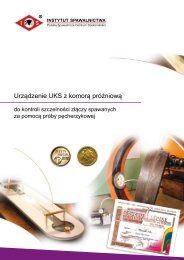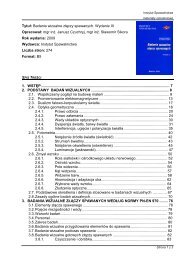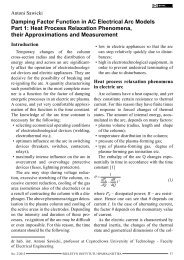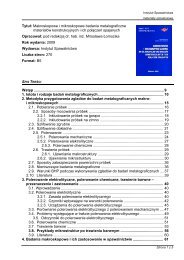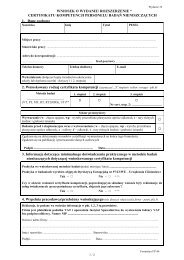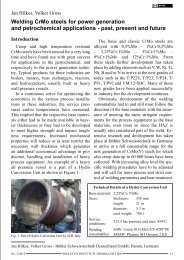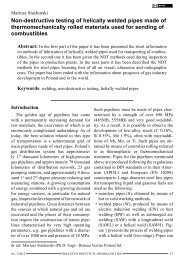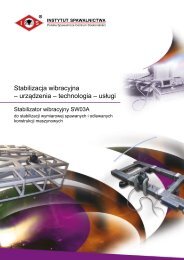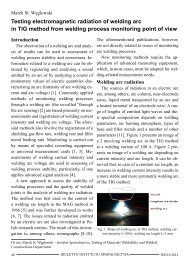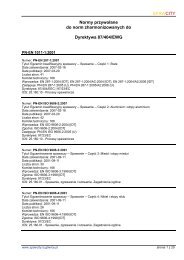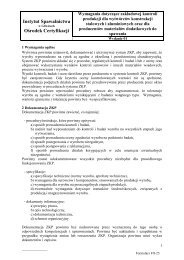Improving the operating properties of coal mining machinery elements
Improving the operating properties of coal mining machinery elements
Improving the operating properties of coal mining machinery elements
You also want an ePaper? Increase the reach of your titles
YUMPU automatically turns print PDFs into web optimized ePapers that Google loves.
Artur Czupryński, Jacek Górka, Jarosław Ślosarczyk<br />
<strong>Improving</strong> <strong>the</strong> <strong>operating</strong> <strong>properties</strong> <strong>of</strong> <strong>coal</strong> <strong>mining</strong><br />
<strong>machinery</strong> <strong>elements</strong><br />
Abstract: It has been presented a possibility <strong>of</strong> improvement in <strong>operating</strong> <strong>properties</strong><br />
<strong>of</strong> mine skip buckets in drawing engines, made <strong>of</strong> S355 steel, by welding <strong>of</strong><br />
lining <strong>elements</strong> made <strong>of</strong> Hardox 450 steel to places mostly exposed to abrasive-dynamical<br />
degradation.<br />
Keywords: <strong>coal</strong> mines, mine skip buckets, S355J0, Hardox 450<br />
Introduction<br />
In Polish <strong>coal</strong> mines shaft hoists have<br />
seen many years <strong>of</strong> operation, requiring <strong>the</strong><br />
necessity <strong>of</strong> regenerating worn <strong>elements</strong>. At<br />
<strong>the</strong> moment, one <strong>of</strong> <strong>the</strong> problems which limit<br />
maintaining <strong>the</strong> continuity <strong>of</strong> a technological<br />
process is <strong>the</strong> necessity <strong>of</strong> <strong>the</strong> periodical<br />
exchange <strong>of</strong> <strong>mining</strong> <strong>machinery</strong> <strong>elements</strong> exposed<br />
to abrasion and dynamic loads. It is<br />
important to replace <strong>elements</strong> exposed to <strong>the</strong><br />
greatest loads with materials characterised<br />
by a greater resistance to abrasion and dynamic<br />
loads than <strong>the</strong> previously used structural<br />
steel S355. Criteria conditioning <strong>the</strong><br />
selection <strong>of</strong> a proper steel grade for lining<br />
sheets in zones characterised by <strong>the</strong> highest<br />
exposition to dynamic and abrasive degradation<br />
not only include very high mechanical<br />
<strong>properties</strong> but also good weldability for various<br />
welding techniques while joining such<br />
a steel grade with steel S355. High abrasive<br />
resistance, significantly higher than that <strong>of</strong><br />
steel S355 and good weldability is characteristic<br />
<strong>of</strong> low-alloy martensitic steel Hardox<br />
450 [1-4]. However, due to a price approximately<br />
three times higher than that <strong>of</strong> steel<br />
S355 it is economically justified to use <strong>the</strong><br />
steel for replacing only such lining <strong>elements</strong><br />
which are most exposed to abrasive-dynamic<br />
wear. A particularly exposed zone is <strong>the</strong> one<br />
containing upper sheets located centrally in<br />
relation to <strong>the</strong> winning inlet and skip hoist<br />
container (see Figure 1).<br />
Fig. 1. Damage to lining sheets <strong>of</strong> skip hoist caused by<br />
<strong>mining</strong> winning falling into skip during loading<br />
In consequence, it has become necessary<br />
to develop an efficient technology for repair<br />
welding <strong>of</strong> a shaft skip hoist bucket with reference<br />
to joining steel S355 <strong>elements</strong> with<br />
steel Hardox 450 lining sheets and implement<br />
this technology for repairing <strong>elements</strong><br />
<strong>of</strong> <strong>mining</strong> <strong>machinery</strong>.<br />
Tests and results<br />
The technologies applied in <strong>the</strong> tests were<br />
MMA welding and MAG welding <strong>of</strong> plates<br />
dr inż. Artur Czupryński (PhD Eng.), dr inż. Jacek Górka (PhD Eng.), mgr inż. Jarosław Ślosarczyk<br />
(MSc Eng.) – Silesian University <strong>of</strong> Technology in Gliwice, Chair <strong>of</strong> Welding Engineering<br />
44 BIULETYN INSTYTUTU SPAWALNICTWA<br />
No. 4/2013
(200×400×8 mm) made <strong>of</strong> steel Hardox 450<br />
with plates made <strong>of</strong> steel S355J0. For each<br />
welding method one test plate combining<br />
two grades was prepared. Tables 1 and 2<br />
present <strong>the</strong> chemical compositions and basic<br />
mechanical <strong>properties</strong> <strong>of</strong> sheets intended for<br />
welding on <strong>the</strong> basis <strong>of</strong> certificates issued by<br />
<strong>the</strong> manufacturers.<br />
For each welding method one type <strong>of</strong> a<br />
filler metal produced by <strong>the</strong> ESAB sp. z o. o.<br />
company was selected. The MMA welding<br />
(process 111) involved <strong>the</strong> use <strong>of</strong> low-hydrogen<br />
covered electrodes OK 48.00 with a<br />
low hydrogen content (below 5 ml per 100<br />
g <strong>of</strong> weld deposit), whereas <strong>the</strong> MAG welding<br />
(process 135) involved <strong>the</strong> use <strong>of</strong> a solid<br />
Steel<br />
grade<br />
Table 1. Chemical compositions <strong>of</strong> base metals <strong>of</strong> steel Hardox 450 and steel S355J0<br />
Alloying element content, %<br />
C Si Mn P S Cr Ni Mo B N<br />
Carbon<br />
equivalent<br />
C E , %<br />
Hardox<br />
450<br />
0.20 0.3 1.25 0.01 0.002 0.2 0.04 0.009 0.001 0.45<br />
S355J0 0.19 0.36 1.20 0.03 0.02 - - - - 0.009 0.39<br />
Table 2. Mechanical <strong>properties</strong> <strong>of</strong> base metals <strong>of</strong> steel Hardox 450 and steel S355J0<br />
Steel grade<br />
Hardness,<br />
Testing<br />
R<br />
HBW<br />
m , MPa R e , MPa A 5 , % KV, J<br />
temperature, °C<br />
Hardox 450 461 1430 1210 10 40 -40<br />
S355J0 - 595 365 22 27 0<br />
R m – tensile strength, R e – yield point, A 5 – elongation, KV – impact energy<br />
Filler metal<br />
Table 3. Chemical composition and mechanical <strong>properties</strong> <strong>of</strong> filler metals<br />
Alloying element content, %<br />
Minimum mechanical<br />
<strong>properties</strong><br />
MPa % J<br />
C Si Mn P S Ni Mo Ti R m R e A 5 KV -40<br />
OK. 48.00 0.06 0.5 1.2 0.02 0.015 - - - 540 445 29 70<br />
OK Autrod 13.25 0.08 0.6 1.8 - - 1.0 0.4 0.15 700 620 20 90<br />
R m – tensile strength, R e – yield point, A 5 – elongation, KV – impact energy.<br />
Table 4. Process parameters <strong>of</strong> MMA welding (111) and MAG welding (135)<br />
Electrode<br />
Welding rate, Heat supplied,<br />
Current, A Arc voltage, V<br />
Run no. diameter, mm<br />
mm/min kJ/mm<br />
(111) (135) (111) (135) (111) (135) (111) (135) (111) (135)<br />
1 2.50<br />
75 132 21 18.7 75 240 1.008 0.555<br />
2 3.25 120 235 22 26.0 150 460 0.845 0.717<br />
1.2<br />
3 3.25 130 241 22 26.3 140 440 0.981 0.778<br />
4 4.00 160 238 24 26.1 210 430 0.878 0.780<br />
5 4.00 - 170 - 24 - 210 - 0.933 -<br />
Prior to welding, covered electrodes were dried at ~350°C for 2 hours.<br />
Welding was carried out with DC (+) on <strong>the</strong> electrode. Shielding gas flow rate in MAG welding<br />
(mixture 82%Ar and 18%CO 2 ) ~15 l/min.<br />
No. 4/2013 BIULETYN INSTYTUTU SPAWALNICTWA<br />
45
Table 5. Measurements results obtained in static tensile test <strong>of</strong> MMA<br />
welded joints (111)<br />
Sample<br />
no.<br />
Sample<br />
cross-section<br />
area S 0 , mm 2<br />
Breaking<br />
force F m , kN<br />
Tensile<br />
strength<br />
R m , MPa<br />
Elongation<br />
A 5 , %<br />
1 1 179.57 106 590.30 19.7<br />
1 2 173.66 101 581.60 20.3<br />
Table 6. Measurements results obtained in static tensile test <strong>of</strong> MAG<br />
welded butt joints (135)<br />
Sample<br />
no.<br />
Sample crosssection<br />
area<br />
S 0 , mm 2<br />
Breaking<br />
force F m , kN<br />
Tensile<br />
strength R m ,<br />
MPa<br />
Elongation<br />
A 5 , %<br />
1 1 179.36 105 585.41 20.8<br />
1 2 183.38 106 578.03 20.1<br />
Table 7. Results <strong>of</strong> impact tests <strong>of</strong> MMA butt-welded joint (111)<br />
Sample<br />
no.<br />
Notch<br />
location<br />
Sample dimensions<br />
(at notch location)<br />
h, mm b, mm S 0 , mm 2<br />
Measurement<br />
results<br />
KV, J<br />
73<br />
3 1<br />
3 4 Weld<br />
71<br />
3 7 78<br />
3 2 39<br />
HAZ side<br />
3 5 3 10 0,3 35<br />
S355J0<br />
3 8 28<br />
3 3 65<br />
HAZ side<br />
3 6 57<br />
Hardox 450<br />
3 9 57<br />
h, b – height and width <strong>of</strong> <strong>the</strong> sample at notch location, S 0 – sample<br />
cross-section area at notch location, KV – energy used for<br />
breaking <strong>the</strong> sample or drawing between supports<br />
Table 8. Results <strong>of</strong> impact tests <strong>of</strong> MAG butt-welded joint (135)<br />
Sample<br />
no.<br />
Notch<br />
location<br />
Sample dimensions<br />
(at notch location)<br />
h, mm b, mm S a 0 , mm 2<br />
Measurement<br />
results<br />
KV, J<br />
51<br />
3 1<br />
3 4 Weld<br />
62<br />
3 7 68<br />
3 2 23<br />
HAZ side<br />
3 5 3 10 0,3 22<br />
S355J0<br />
3 8 23<br />
3 3 74<br />
HAZ side<br />
3 6 72<br />
Hardox 450<br />
3 9 71<br />
h, b – height and width <strong>of</strong> <strong>the</strong> sample at notch location, S 0 – sample<br />
cross-section area at notch location, KV – energy used for<br />
breaking <strong>the</strong> sample or drawing between supports<br />
low-alloy copper electrode<br />
wire OK Autrod 13.25. The<br />
chemical composition and <strong>the</strong><br />
basic mechanical <strong>properties</strong> <strong>of</strong><br />
<strong>the</strong> filler metals are presented<br />
in Table 3.<br />
The edges <strong>of</strong> plates to be<br />
welded were bevelled in accordance<br />
with standard PN-EN<br />
ISO 9692-1:2008 obtaining a<br />
V-shaped weld groove with an<br />
angle <strong>of</strong> 55°. The plates were<br />
welded without preheating, in<br />
vertical up position (PF), not<br />
exceeding an interpass temperature<br />
<strong>of</strong> 150°C. Joints were<br />
made in a multi-run manner.<br />
Process parameters were selected<br />
on <strong>the</strong> basis <strong>of</strong> results<br />
obtained in <strong>the</strong> initial welding<br />
tests (Table 4).<br />
The test joints underwent<br />
visual testing and radiographic<br />
testing 72 hours following<br />
<strong>the</strong> welding process completion.<br />
No welding imperfections<br />
eliminating <strong>the</strong> joints from fur<strong>the</strong>r<br />
tests were detected. The<br />
radiographic tests were carried<br />
out in accordance with <strong>the</strong> requirements<br />
<strong>of</strong> standard PN-EN<br />
1435:2001. The radiograms revealed<br />
<strong>the</strong> presence <strong>of</strong> single<br />
pores in <strong>the</strong> welds; <strong>the</strong> dimensions<br />
<strong>of</strong> <strong>the</strong> pores were contained<br />
within <strong>the</strong> joint quality<br />
<strong>of</strong> level B according to PN-EN<br />
ISO 5817:2009.<br />
The static tensile tests were<br />
carried out in accordance with<br />
<strong>the</strong> requirements <strong>of</strong> standard<br />
PN-EN ISO 4136:2013-05E.<br />
In each test <strong>the</strong> samples underwent<br />
rupture outside <strong>the</strong> welded<br />
joint area in <strong>the</strong> base metal<br />
46 BIULETYN INSTYTUTU SPAWALNICTWA<br />
No. 4/2013
<strong>of</strong> steel S355J0. The results <strong>of</strong> measurements<br />
concerning MMA and MAG welded butt<br />
joints are presented in Tables 5 and 6.<br />
Charpy V-notch tests on <strong>the</strong> samples<br />
were carried out at ~20°C<br />
in accordance with standard<br />
PN-EN ISO 9016:2011. Due<br />
to <strong>the</strong> thickness <strong>of</strong> <strong>the</strong> tests<br />
plates amounting to 8 mm<br />
and <strong>the</strong> necessity <strong>of</strong> mechanical<br />
working <strong>of</strong> <strong>the</strong> samples,<br />
<strong>the</strong>ir thickness was reduced<br />
to 5 mm. A notch was made<br />
in <strong>the</strong> weld and HAZ. The results<br />
<strong>of</strong> <strong>the</strong> tests involving <strong>the</strong><br />
butt joints made by means <strong>of</strong><br />
methods 111 and 135 are presented<br />
in Tables 7 and 8.<br />
The butt joints underwent<br />
bend tests in accordance<br />
with standard PN-EN<br />
ISO 5173:2010/A1:2012 with<br />
bending from <strong>the</strong> weld face<br />
side (FBB) and bending from<br />
<strong>the</strong> weld root side (RBB). A<br />
bending mandrel was selected<br />
on <strong>the</strong> basis <strong>of</strong> data contained<br />
in standard PN-EN<br />
ISO 15614-1. The bend test<br />
results were acceptable for<br />
each welding method. Bending<br />
angles obtained were<br />
from 130° to 155° (greater for<br />
RBB). No cracks in <strong>the</strong> joint<br />
were revealed.<br />
Vickers hardness tests were<br />
conducted in accordance with<br />
standard PN-EN ISO 6507-<br />
1:2007. The tested cross-section<br />
<strong>of</strong> <strong>the</strong> MMA-welded (111)<br />
and MAG-welded (135) joint<br />
sample with measurement<br />
points located along measurement<br />
lines A and B are presented<br />
in Figure 2. Figures 3 and 4<br />
A<br />
present <strong>the</strong> hardness distribution curves in<br />
<strong>the</strong> joints made using methods 111 and 135.<br />
In <strong>the</strong> case <strong>of</strong> both welding technologies,<br />
macroscopic tests revealed <strong>the</strong> proper shape<br />
1 2 3 4 5 6 7 8 9 10 11 12 13 14 15<br />
S355J0 HARDOX 450<br />
B 1 2 3 4 5 6 7 8 9 10 11 12 13 14 15<br />
Hardness HV<br />
Hardness HV<br />
Fig. 2. Location <strong>of</strong> hardness measurement points in welded joins<br />
450<br />
400<br />
350<br />
300<br />
250<br />
200<br />
150<br />
100<br />
1 2 3 4 5 6 7 8 9 10 11 12 13 14 15<br />
(S355J0) (HAZ (weld) (HAZ (Hardox 450)<br />
S355J0)<br />
Hardox 450)<br />
number <strong>of</strong> measurement point<br />
(measurement location)<br />
Hardness from weld face side<br />
Hardness from weld root side<br />
Fig. 3. Curves <strong>of</strong> hardness distribution in MMA-welded joins (111)<br />
500<br />
450<br />
400<br />
350<br />
300<br />
250<br />
200<br />
150<br />
100<br />
1 2 3 4 5 6 7 8 9 10 11 12 13 14 15<br />
S355J0 HAZ weld HAZ Hardox 450<br />
S355J0<br />
Hardox 450<br />
number <strong>of</strong> measurement point<br />
(measurement location)<br />
Hardness from weld face side<br />
Hardness from weld root side<br />
Fig. 4. Curves <strong>of</strong> hardness distribution in MAG-welded joins (135)<br />
No. 4/2013 BIULETYN INSTYTUTU SPAWALNICTWA<br />
47
<strong>of</strong> a weld face and a weld root as well as <strong>the</strong><br />
proper shape <strong>of</strong> fusion into <strong>the</strong> base metal.<br />
No blowholes or slag inclusions in <strong>the</strong> weld<br />
were detected. The results <strong>of</strong> microscopic<br />
tests are presented in Figures 5-7.<br />
a) b)<br />
Fig. 5. Base metal macrostructure <strong>of</strong>:<br />
a) steel Hardox 450 – high-tempered martensite structure;<br />
b) steel S355J0 – ferritic-pearlitic structure;<br />
mag. x200, etchant Mi1Fe<br />
Hardox 450<br />
HAZ<br />
weld<br />
weld<br />
Fig. 6. Microstructure <strong>of</strong> MMA-welded joint (111); mag. x200, etchant Mi1Fe<br />
Hardox 450<br />
HAZ<br />
weld<br />
weld<br />
Fig. 7. Microstructure <strong>of</strong> MAG-welded joint (135); mag. x200, etchant Mi1Fe<br />
The tests aimed to determine resistance<br />
to abrasive wear were carried out in accordance<br />
with <strong>the</strong> recommendations <strong>of</strong> standard<br />
ASTM G 65-00, Procedure A. In order to<br />
conduct <strong>the</strong> tests it was necessary to cut two<br />
samples out <strong>of</strong> <strong>the</strong> welded joints; <strong>the</strong> dimensions<br />
<strong>of</strong> <strong>the</strong> samples were 75×25×8 mm. The<br />
faces <strong>of</strong> <strong>the</strong> welds were ground to <strong>the</strong> plate<br />
surface. The tests also involved <strong>the</strong> preparation<br />
<strong>of</strong> two samples (having <strong>the</strong> same dimensions)<br />
cut out <strong>of</strong> steel Hardox 450 plate and<br />
two samples cut out <strong>of</strong> steel S355J0 plate.<br />
Before and after <strong>the</strong> abrasive resistance tests,<br />
all <strong>the</strong> samples, following <strong>the</strong> instructions <strong>of</strong><br />
standard ASTM G 65-00, were weighed with<br />
an accuracy <strong>of</strong> 0.0001 g. The mass loss <strong>of</strong><br />
<strong>the</strong> welded joints and <strong>the</strong><br />
S355J0<br />
mass loss <strong>of</strong> <strong>the</strong> samples<br />
made <strong>of</strong> steel S355J0<br />
HAZ<br />
were compared directly<br />
with <strong>the</strong> mass loss <strong>of</strong><br />
weld <strong>the</strong> samples made <strong>of</strong> steel<br />
Hardox 450. During <strong>the</strong><br />
test a frictional wheel<br />
S355J0 made six thousand revolutions.<br />
The abrasive material<br />
flow rate was 335<br />
HAZ<br />
g/min. The force exerted<br />
on <strong>the</strong> samples during <strong>the</strong><br />
weld<br />
test amounted to 130 N.<br />
The results obtained in<br />
Table 9. Results <strong>of</strong> metal-mineral abrasive resistance tests <strong>of</strong> welds made with methods (111), (135) and <strong>of</strong> steel<br />
S355J0 plate, related to abrasive resistance <strong>of</strong> steel Hardox 450; reference standard ASTM G 65-00<br />
Sampling Sample Mass before Mass after<br />
Average Relative abrasive<br />
Mass loss, g<br />
spot designation test, g tests, g<br />
mass loss, g resistance, %<br />
Joint (111)<br />
1S 1 117.1719 115.1279 2.0440<br />
1S 2 116.8654 114.8248 2.0406<br />
2.0423 72.53<br />
Joint (135)<br />
3S 1 115.5903 113.5186 2.0717<br />
3S 2 115.8544 113.7852 2.0692<br />
2.0704 71.54<br />
S355J0<br />
P 1 115.3390 113.5577 1.7813<br />
P 2 116.4360 114.6254 1.8106<br />
1.7960 82.47<br />
Hardox H 1 116.2391 114.7533 1.4858<br />
450 H 2 117.1134 115.6368 1.4766<br />
1.4812 100<br />
Results were referred to <strong>the</strong> samples made <strong>of</strong> Hardox 450 plate. The force exerted on <strong>the</strong> samples during<br />
<strong>the</strong> test was 130N.<br />
48 BIULETYN INSTYTUTU SPAWALNICTWA<br />
No. 4/2013
<strong>the</strong> tests and <strong>the</strong> calculated<br />
relative metal-mineral<br />
abrasive resistance <strong>of</strong> individual<br />
welds referring<br />
to steel Hardox 450 are<br />
presented in Table 9 and<br />
in Figure 8.<br />
Concluding remarks<br />
Relative abrasive resistance<br />
The analysis <strong>of</strong> <strong>the</strong> results<br />
<strong>of</strong> <strong>the</strong> tests dedicated<br />
to <strong>the</strong> development <strong>of</strong><br />
a technology for repair<br />
welding <strong>of</strong> a shaft skip<br />
hoist bucket using MMA<br />
welding (111) with a low-hydrogen electrode<br />
OK 48.00 and MAG welding (135) with a<br />
welding wire OK Autrod 13.25 makes it possible<br />
to formulate <strong>the</strong> following conclusions:<br />
1. NDT and DT <strong>of</strong> butt joints <strong>of</strong> steel<br />
S355J0 welded with steel Hardox 450 by<br />
means <strong>of</strong> methods 111 and 135 revealed that<br />
<strong>the</strong> technology developed for welding by<br />
means <strong>of</strong> <strong>the</strong> aforesaid methods ensures <strong>the</strong><br />
acceptable quality <strong>of</strong> such joints.<br />
2. The metal-mineral abrasive resistance<br />
<strong>of</strong> <strong>the</strong> MMA-welded butt joints with<br />
a low-hydrogen electrode OK 48.00 and <strong>of</strong><br />
<strong>the</strong> MAG-welded joints made with a welding<br />
wire OK Autrod 13.25 constitutes approximately<br />
70% <strong>of</strong> <strong>the</strong> relative abrasive wear resistance<br />
<strong>of</strong> Hardox 450 steel.<br />
3. The amount <strong>of</strong> supplied heat ensuring<br />
<strong>the</strong> production <strong>of</strong> high-quality joints is higher<br />
in method 111 and very similar to <strong>the</strong> boundary<br />
value <strong>of</strong> welding linear energy being 1.0<br />
kJ/mm, which according to recommendations<br />
<strong>of</strong> <strong>the</strong> producer <strong>of</strong> steel Hardox 450 for<br />
weld (111) weld (135) S355J0 Hardox 450<br />
point od measurement<br />
Fig. 8. Relative metal-mineral abrasive resistance <strong>of</strong> welds made with methods<br />
(111) and (135) and <strong>of</strong> S355J0 plate in relation to abrasive resistance <strong>of</strong> steel<br />
Hardox 450<br />
8 mm thick plates should not be exceeded.<br />
4. The tests results obtained indicate <strong>the</strong><br />
possibility <strong>of</strong> improving <strong>the</strong> operational<br />
<strong>properties</strong> <strong>of</strong> a shaft skip hoist bucket made<br />
<strong>of</strong> steel S355 by providing <strong>the</strong> areas most exposed<br />
to abrasive-dynamic degradation with<br />
lining <strong>elements</strong> made <strong>of</strong> Hardox 450 steel.<br />
References<br />
1. Kou, S. 2003. Welding metallurgy. Ed.2,<br />
Hoboken, N.J.: Wiley-Interscience.<br />
2. Welding <strong>of</strong> Weldox and Hardox. SSAB-<br />
-Oxelösund materials.<br />
3. Hardox wear plate. Properties and Processing,<br />
SSAB-Oxelösund materials, 2008.<br />
4. Konat, Ł. Pękalski, G. (2006). “Structures<br />
and selected <strong>properties</strong> <strong>of</strong> Hardox steels<br />
in <strong>the</strong> context <strong>of</strong> <strong>the</strong>ir use in surface <strong>mining</strong><br />
<strong>machinery</strong> construction”. XV International<br />
Symposium on Mine Planning<br />
and Equipment Selection (MPES 2006),<br />
20-22, Torino-Italy, vol.1, pp. 142-147.<br />
No. 4/2013 BIULETYN INSTYTUTU SPAWALNICTWA<br />
49



